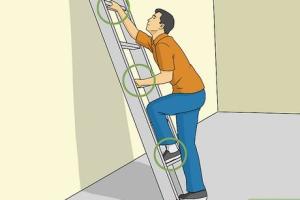Ultimate Guide to Climbing a Ladder Safely: Tips & Techniques

-
Quick Links:
- Introduction
- Ladder Safety Statistics
- Types of Ladders
- Choosing the Right Ladder
- Preparing Your Ladder
- Climbing Techniques
- Common Mistakes to Avoid
- Case Study: Ladder Safety in Construction
- Expert Insights on Ladder Safety
- Conclusion
- FAQs
Introduction
Climbing a ladder may seem like a simple task, but it carries significant risks if not done correctly. Every year, thousands of people are injured from ladder-related accidents. Understanding how to climb a ladder safely is crucial, whether you are a DIY enthusiast, a professional contractor, or just need to reach something high in your home.
Ladder Safety Statistics
According to the U.S. Bureau of Labor Statistics, ladder-related injuries account for approximately 20,000 emergency room visits each year. The National Institute for Occupational Safety and Health (NIOSH) reports that falls from ladders are the leading cause of construction fatalities.
- Over 50% of ladder-related injuries happen due to improper use.
- Men are more likely to suffer ladder falls than women, with an injury rate of 81%.
- About 25% of all ladder falls result in serious injuries, including fractures and head trauma.
Types of Ladders
Understanding the different types of ladders and their uses is vital for ensuring safety. Here are some common types:
- Step Ladders: Ideal for indoor use, these ladders are self-supporting and have flat steps.
- Extension Ladders: Used for reaching higher places, they can be extended to various heights.
- Platform Ladders: These provide a stable platform to work from, often used in commercial settings.
- Multi-Position Ladders: Versatile ladders that can be configured in various ways for different tasks.
Choosing the Right Ladder
Selecting the right ladder is the first step to climbing safely. Consider the following factors:
- Height: Choose a ladder that reaches the height you need without overreaching.
- Weight Capacity: Ensure the ladder can support your weight plus any tools or materials you’re carrying.
- Material: Ladders can be made from aluminum, fiberglass, or wood. Choose based on your specific needs, like electrical safety or durability.
Preparing Your Ladder
Preparation is key to ladder safety. Follow these steps:
- Inspect the ladder for any damages or wear.
- Ensure the ladder is on a stable, flat surface.
- Set the angle of the ladder at about 75 degrees.
- Secure the ladder at the top to prevent slipping.
Climbing Techniques
Once you are prepared, use the following climbing techniques:
- Always maintain three points of contact: two hands and one foot, or two feet and one hand.
- Face the ladder while climbing or descending.
- Keep your body centered between the rails.
Common Mistakes to Avoid
Avoid these common mistakes when climbing a ladder:
- Overreaching: Keep your body within the ladder’s side rails.
- Carrying tools in your hands: Use a tool belt or hoist tools up after you.
- Ignoring weather conditions: Avoid using ladders in high winds or rain.
Case Study: Ladder Safety in Construction
A recent study conducted by the Occupational Safety and Health Administration (OSHA) highlighted the importance of ladder safety in the construction industry. The study found that companies that implemented comprehensive ladder safety training saw a 40% reduction in ladder-related incidents among their workers.
Expert Insights on Ladder Safety
We consulted with safety experts to gather insights on ladder safety:
"Proper training and awareness are critical in preventing ladder accidents. Regular safety checks can significantly reduce risk." - John Smith, Safety Consultant
Conclusion
Climbing a ladder safely is not just about following rules, but also about understanding your environment and the equipment you are using. By following the guidelines outlined in this article, you can significantly reduce the risk of accidents and injuries.
FAQs
- What is the safest way to climb a ladder? Always maintain three points of contact and keep your body centered.
- How often should I inspect my ladder? Inspect your ladder before each use.
- Can I use a ladder on uneven ground? It is not safe; always use a ladder on a stable surface.
- What height ladder do I need? Choose a ladder that allows you to reach your desired height without overreach.
- Is it safe to use a ladder in windy conditions? No, avoid using ladders in high winds.
- What should I do if my ladder slips? Try to maintain your balance and follow proper dismount techniques.
- Can I carry tools while climbing? No, use a tool belt instead.
- How can I prevent ladder injuries? Follow safety guidelines and participate in ladder safety training.
- Are fiberglass ladders safer than aluminum? Yes, fiberglass ladders are non-conductive, making them safer for electrical work.
- What is the maximum weight limit for ladders? This varies by ladder type; always check the manufacturer's specifications.
Random Reads
- How to play pinball like a pro
- How to play minecraft
- How to fix squeaking ceiling fan
- How to fix unrecognized usb disk
- How to type trademark symbol
- How to type roman numerals
- Fix nintendo switch not connecting to tv
- Download summertime saga android apk
- Always display bookmarks in chrome
- How to enable developer mode iphone ipad